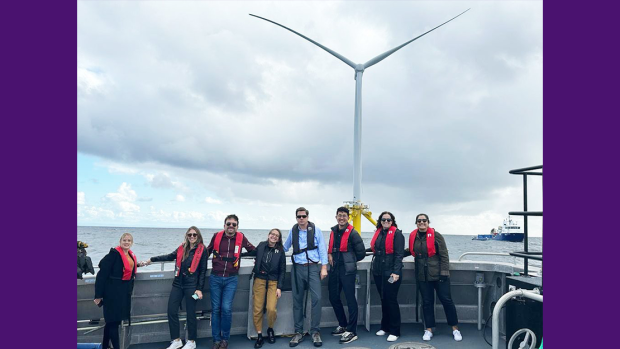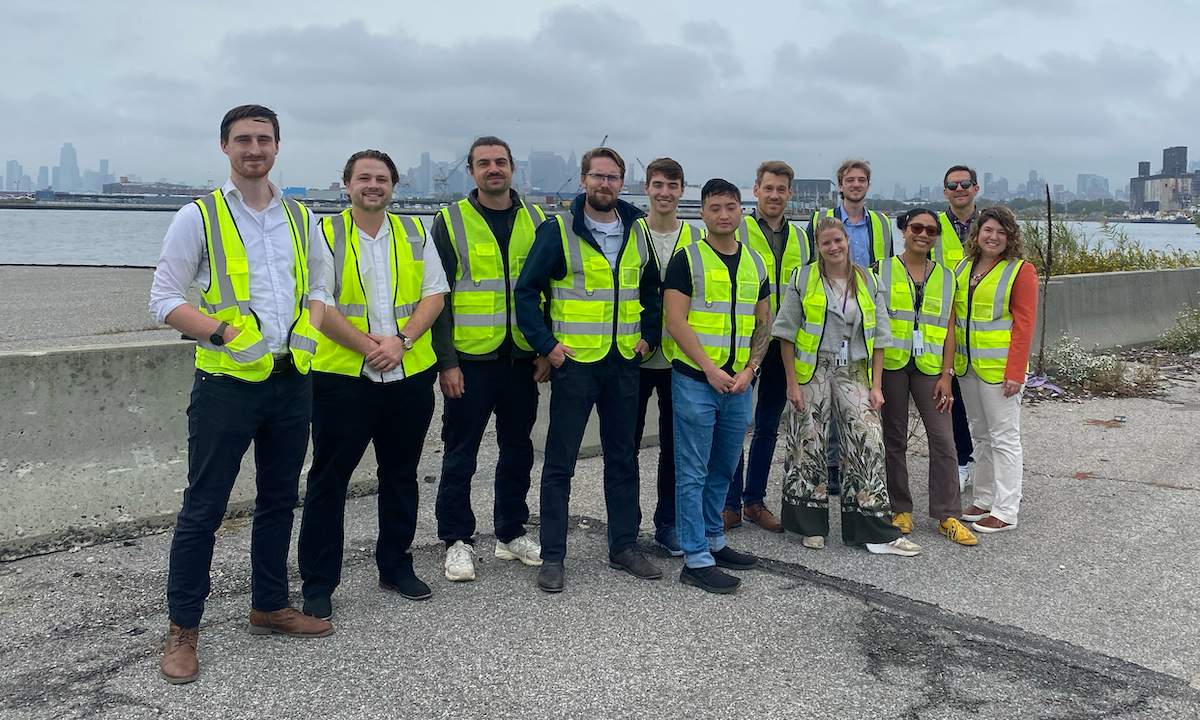The Offshore Wind Innovation Hub graduates an impressive cohort of start-ups

The first cohort of graduates of the Offshore Wind Innovation Hub are poised to harness the power of wind
New York State has set a target of 100% clean electricity by 2040, and along the way, it aims to create 9,000 megawatts of offshore wind by 2035 — with the necessary transmission infrastructure to ensure continued electric reliability and with much of that power connected directly into NYC.
NYU Tandon is doing its part to make those goals a reality. In mid-2022, the school and its Urban Future Lab joined with the National Offshore Wind Research & Development Consortium (NOWRDC) and the New York City Economic Development Corporation (NYCEDC) to help launch the Offshore Wind Innovation Hub (OWIH) in Brooklyn’s Industry City.
The Hub, dedicated to identifying and developing promising start-ups to drive new innovations in the offshore wind industry, is being led by energy company Equinor, one of the largest offshore wind developers in the world, and energy giant bp, which have joined forces to provide more than three gigawatts of power to the State (a substantial contribution to the 2035 goal and enough to power some two-million homes) while also encouraging community-based initiatives like the OWIH.
This summer, the Hub’s highly competitive and intensive six-month accelerator program accepted its first cohort of innovators, which were provided with physical office space, industry mentorship, advisory services, bespoke commercialization and development assistance from program partners, group workshops, site visits, expert talks, accounting services and support in raising capital, and even individualized collaboration with Equinor to validate and test their new technologies.
The companies in the cohort are:
- Benchmark Labs, which creates AI-based, hyper-accurate environmental forecasts, recommendations, and alerts
- Flucto, whose mission is to bring the installation of offshore wind farms into the digital age with custom-built sensors and software
- Heerema Engineering Solutions, which gives clients the benefit of expert knowledge of hydrodynamics and structural engineering, with a strong focus on automation and understanding how to best adapt to ever-changing codes and standards
- OSC, which prides itself on being the world’s most advanced provider of simulators for demanding offshore operations
- RCAM Technologies, which uses 3D printing technologies to manufacture low-cost, concrete renewable-energy support structures and systems
- VinciVR, which provides workforce recruitment, filtering, and training Virtual Reality tools for the offshore wind market

What’s your why?
The founders all cited concern for the planet as the major reason they had been drawn to the offshorewind industry. “Coming from Norway, with breathtaking fjords, pristine waters and clean energy, we pride ourselves on living close to untouched nature,” Pierre Major, the VP of Business Development and Head of Research at OSC, says.”But we see that climate change and biodiversity loss are taking effect everywhere in the world, including Norway, so it’s our generation’s duty to do everything we can to mitigate and reverse the damages caused.” (The issue of the next generation hits close to home for Silvan Slijpen of Heerema Engineering Solutions, as well: he has two children to consider.)
Other concerns also came into play. Carlos Gaitan, the CEO and co-founder of Benchmark Labs, grew up in Colombia, the second largest producer of coffee beans in the world, with a mother who worked in that industry. Varying microclimates (such as when conditions on one side of a mountain are different from those on the other side) can have serious repercussions for crops, he explains, and when a major crop suffers, so can the economy. “That’s why accurate, hyper-local forecasts like the ones Benchmark provides are so vital,” he says.
Other founders had pivotal “a-ha” moments. Eagle Wu, the co-founder and CEO of Vinci VR, was already interested in virtual reality’s potential for education and workforce training, but when he attended an event at Massachusetts Clean Energy Center, he knew, as he says, “I had found my niche.” Founder and CEO of RCAM Technologies Jason Cotrell had his own epiphany during a visit to Oak Ridge National Laboratory, where he saw 3D printers as large as conference rooms and realized that the 3D printing with concrete would make it easy to print massive infrastructure components on-site–of particular interest when those components are too big to ship.
Then there’s the case that wind energy is simply a fun, engaging field. Aljoscha Sander, a founder and managing director of Flucto asserts that although it can be hard for a researcher to find a job that is not only socially beneficial and adequately paid but fun. “Wind power checks all those boxes,” he says.”Investors could actually miss out if they disregard the value of fun.”
Facing challenges head-on
While rewarding (and even fun), launching a start-up is always rife with challenges. Ulrik Soderstrom, a co-founder of Benchmark, who has worked as a data scientist at the Princeton-based agricultural company Arable Labs and at NOAA, where he designed innovative weather forecasting AI algorithms, has ample experience analyzing data, but obtaining that data in the first place can be hard. “There’s something called the wake effect,” he explains, which means that each turbine has a microclimate that affects the next one, but companies are sometimes unwilling to share. “We owe a lot of thanks to Equinor for helping us get the buoy and turbine data we need to better predict factors like wind speed, solar radiation, and cloud cover.”
Sander points out that the industry can be a hard one to break into and that from a research perspective, the deck can sometimes seem stacked since there is competition with non-renewables. Timing can also be an issue: Although Wu found a niche in wind power, Vinci VR still works in other sectors like aviation and defense, because so many wind projects are in the early stages of development, and, as he explains, “workforce training and development is often the very last piece of puzzle.”
It can also be challenging to get both laypeople and industry pros to understand just what’s at stake. “Offshore wind installations are even more complex than moon landings, and we know from our experience in Europe that our simulations save millions of dollars every year by preventing catastrophic missteps before execution or speeding up operations. But people do not understand this easily,” Major says. “We need to attend the right forums and be patient, but is it really the right strategy for the world to be patient when we see increasing floods, wildfires, and hurricanes?”
RCAM faced a more fundamental challenge: that of choosing a name. “The AM stands for additive manufacturing, which was a term used in addition to 3D printing back when the technology was new,” Cotrell recalls. “Most people favor the term 3D printing now, so I guess we chose wrong.”
Reaping the benefits
Being part of the OWIH cohort has been a transformative experience, the founders say. “We’ve been to other very prestigious incubator programs,” Gaitan and Soderstrom recall of their experience getting Benchmark Labs off the ground. “We learned a lot but at this point what we need is not advice on our internal operations but the chance to meet stakeholders and potential clients. Energy contracts traditionally take a long time, so it’s important to act now, and being part of the Hub has allowed us to do that.” That vital networking is made easier by the Hub’s location near the Brooklyn waterfront. “Proximity means a lot,” Wu asserts. “There are times when Zoom just won’t do.”
The networking, as Major points out, also involves talking “to the brightest and most passionate people on the planet.” He continues, “The program has been both an eye opener and a door opener. Understanding the culture, people-wise and business-wise, is key for us, and the program lined up a helpful series of experts on commodities, funding agencies, human resources, tax and legal issues, and financial services. This is a unique opportunity for small companies like us to try to understand and establish ourselves in New York.”
One additional benefit of being connected to a major school like NYU Tandon is access to talented aspiring engineers, Cotrell says: he recently hired mechanical engineering student Natalia Ladino as an intern. Major also offers praise for the independence and problem-solving skill of NYU students, and OSC, as well, has taken on an intern, Nathan Colasuonno.
What’s next?
Now that the accelerator program is nearing its end, the founders are turning their attention to the future.
Benchmark Labs’ founders believe not even the sky is the limit: it’s not only the offshore-wind industry that can benefit from their forecasting, they say; farmers and skiers, among others, are also potential clients. Cotrell is looking forward to obtaining a massive new printer, 30 feet by 30 feet, thanks to funding from NYSERDA. “Maybe one day, there will be one at every major port,” he says. “There seems to be awareness and momentum building, so I’m hopeful.”
Many of the founders point out that the U.S. is an entirely new frontier. “The technology is there, but policy hasn’t quite caught up,” Sander says. Still, there is reason for optimism. “U.S. states are showing great commitment to sustainability and infrastructure,” Slijpen and Heerema managing director Ivan van Winsen say. “And Americans are very concerned now with jobs and carbon neutrality.” Major predicts that OSC could play an important role. “Regulation bodies have stringent safety rules that are sometimes outdated and need to be revisited by policy makers with the help of simulation,” he says. “This will help deploy sustainable solutions such as bottom fixed and floating offshore wind in a faster and safer way.”
“I'm proud that with the backing of all the program partners, we have been able to create a highly impactful accelerator program, which is truly a one-of-a-kind opportunity for global thought-leading innovators to gain the critical insight needed for them to validate and commercialize their solutions," says OWIH director Tone Søndergaard. "They're now equipped with the tools and New York foothold that will enable these companies to create green jobs and boost the economy. And this is just our first cohort, we will publish the next call for innovators in January 2024."
“We’re thrilled by the accomplishments of these emerging entrepreneurs through the Offshore Wind Innovation Hub,” says Teddy Muhlfelder, Vice President East Coast, Equinor Renewables Americas. “Equinor and bp are proud to spearhead this truly unique experience that is providing hands-on support and training during early phase development of offshore wind projects in New York, while building relationships with like-minded peers working towards the same goal: Building New York’s offshore wind future.”

